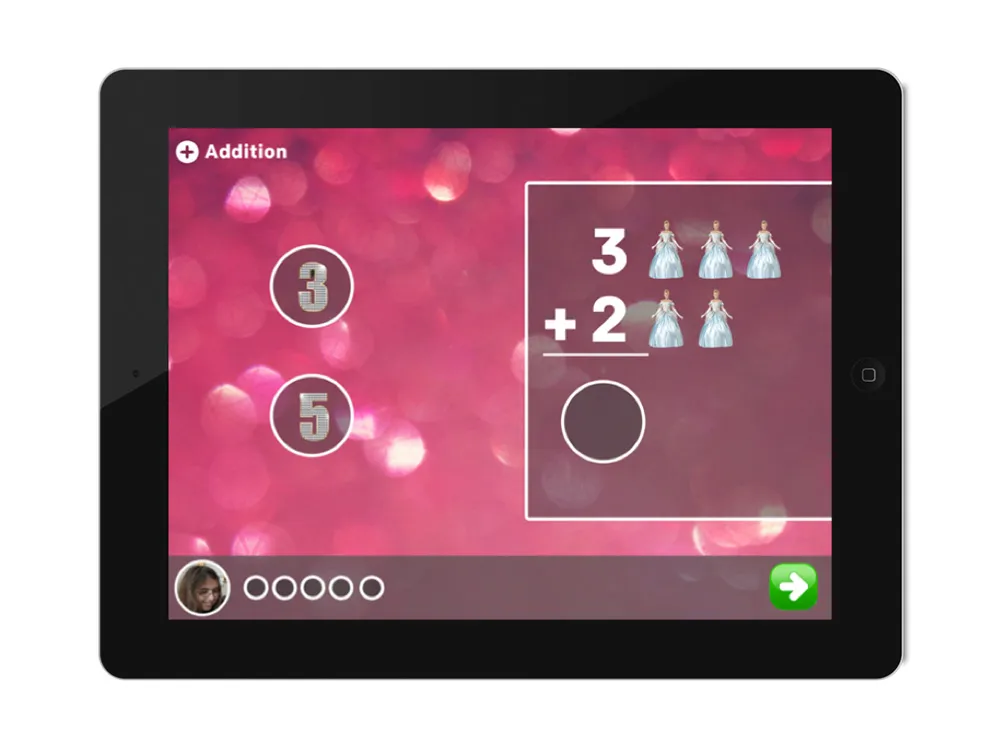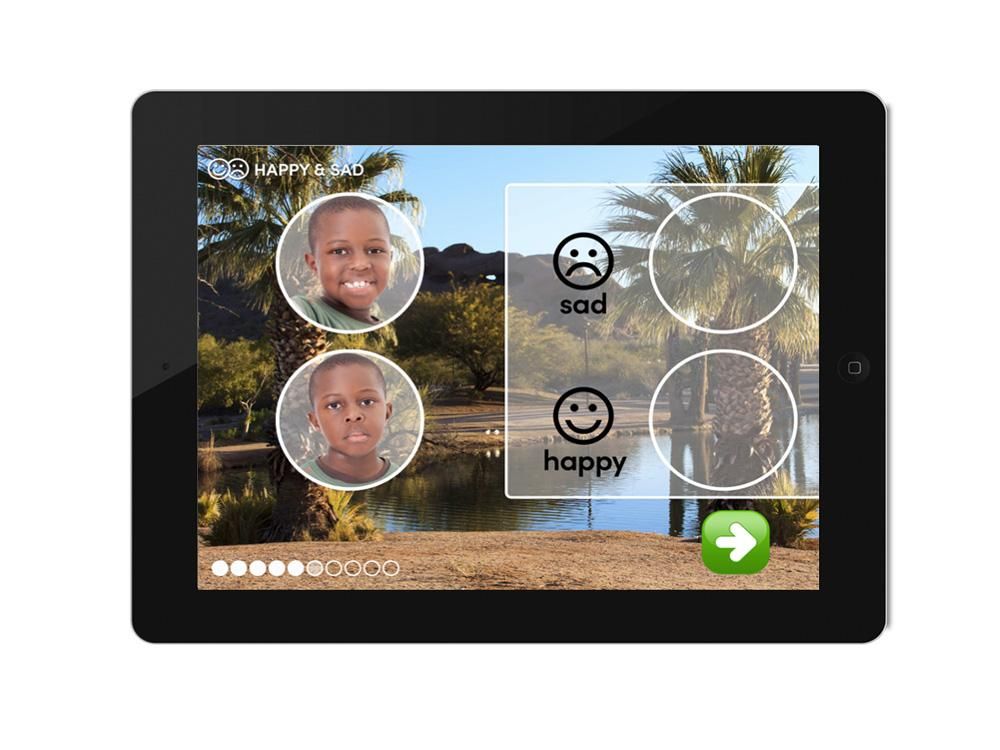These Apps Help Kids With Autism Learn Basic Skills
Infiniteach, a Chicago startup, is building learning tools for the one in 68 children diagnosed with autism spectrum disorders today
/https://tf-cmsv2-smithsonianmag-media.s3.amazonaws.com/filer/6a/af/6aaff819-9b52-45f1-9370-f4dec51fd184/3-3290702682-o.jpg)
For children with autism, math problems are a lot easier if images are involved. Addition, for example, becomes significantly more clear if the equation and answer are accompanied by physical pictures representing the math taking place. Two cars plus three cars is logically depicted with images of five physical cars. Reinforcing every question with a visual reference helps make it more concrete and accessible.
Katie Hench, Christopher Flint and Lally Daley, all of whom have worked with autistic students as special education teachers or therapists, were inspired by their firsthand experiences to establish Infiniteach, a Chicago-based startup building mobile apps that cater to the specific ways that kids with autism learn. Their current app, Skill Champ, teaches ten vital skills, including number matching and object sorting, using approaches proven to resonate with autistic students.
Hench and Flint had been teaching autistic children in homes and schools when they couldn't help but notice a major disconnect. Most families they encountered had tablets for their kids to use, but no suitable apps that effectively taught the lessons the students needed to learn. During their 20 years in the field, the rate of children diagnosed with an autism spectrum disorder increased dramatically, resulting in a dire need for learning tools that could be easily shared to meet the demand. Hench's younger brother, Jon, was diagnosed with autism at age six, and she saw how challenging it was for her family, living in a small town in Ohio, to find the resources necessary to support his education. Hench and Flint share their story with Smithsonian.com.
Let's start with the problem. What problem are you trying to fix?
Today, one in 68 children are being diagnosed with an autism spectrum disorder, a rate that has increased more than 600 percent in the past two decades alone. As you might imagine, resources and services have not kept up with this growing demand. A recent study stated that a "lack of autism specialists is creating wait times for diagnosis and treatment from a month to two years." Even for families who do have access to services, therapy can be incredibly unaffordable, with the most recognized interventions recommending 40 hours per week of intensive one-on-one therapy.
For the Infiniteach team, these statistics are unacceptable. Access to life-changing resources must be available and affordable for all children and their families. We are developing technology that is embedded with best practice autism strategies and can supplement direct therapy interventions, reducing the cost and increasing the availability for all children and families.
So, what exactly is Infiniteach? Could you give me your elevator pitch?
Infiniteach is changing the way we approach autism education. Leveraging technology, we are providing autism resources that are effective, affordable and scalable. Our digital curriculum combines evidence-based autism strategies, customized learning and unique algorithms to help children grow skills over time. The lessons teach Common Core aligned academic skills, as well as social and communication skills—critical areas for the development of individuals on the autism spectrum.

How do children with autism learn differently from other children?
Many children with autism have a unique learning profile. First and foremost, individuals on the autism spectrum are usually better visual learners than auditory learners. Research shows that presenting information visually helps students with autism process and retain information more reliably.
Within our app, we minimize the reliance on auditory information and provide more visual supports for learning. For example, there is an activity that helps verbal students with autism ask appropriate questions to another person: "What's your favorite animal?" or "What music do you like?" The entire lesson is based on visuals. The child chooses a question represented by a picture and a word. The child then drags the question over to their partner's picture and then verbally asks them the question. The parent or teacher then types in the answer. The entire process of asking and answering questions takes advantage of the visual strengths of children with autism, and minimizes auditory processing, which can be difficult.
Children with autism also generally learn best when using structure and routines. They often benefit from errorless learning, which is the opposite strategy that most children use to learn. Children without autism typically use trial and error to master new skills. They attempt an activity and then adapt their performance based on feedback. They learn from their mistakes. A child with autism, on the other hand, is driven by routine. And when they attempt something incorrectly, they actually learn their mistakes. The wrong way becomes part of their routine. Now, in order to master it correctly, we need to go back and unteach the incorrect routine and reteach it the right way—a time-consuming process. Errorless learning is a powerful strategy to help ensure that students with autism always learn skills, routines and activities the correct way from the first time they are introduced. They thrive when expectations are clear and their learning falls within established routines. Presenting information interactively often increases engagement and learning.
Lessons with manipulative and sensory components are usually highly motivating and engaging. Our grouping lesson is an example of how we incorporate these. Grouping is matching a set of objects to a number. For example, if someone asks for "three" spoons, a child will hand them the correct number. In our lesson, we start with a visual number of how many a student needs to find. There are also a number of motivating manipulatives, like sports or animals, on the screen. The student needs to drag the manipulatives one-by-one to get to the correct amount. The lessons have auditory and visual feedback based on whether a child performs the activity right or wrong. And at the end of the lesson, there is a video as a reward.
How does your app, Skill Champ, work?
Skill Champ teaches ten early academic skills, such as picture matching, letter identification and sorting colors. Each skill can be quickly and easily customized based on a child’s interest by combining that skill with any of the ten high-interest themes, including trains, food, zoo animals and princesses. Skill Champ also tracks accuracy data, and each skill includes a printable curriculum to help students generalize the skills they are learning off of the iPad.
How did you come up with this concept?
This is an idea that came out of spending almost two decades in the autism field and seeing autism rates expand faster than we could scale training and individual therapy. In order to make the most meaningful impact, we had to develop a paradigm shift in delivering intervention. As we surveyed the landscape, technology was becoming more ubiquitous and research was showing that tablets were an efficacious intervention for children with autism. We were working in homes and schools where there was access to tablets, but the apps were not meeting the needs of the children. So, we decided to pair expert autism strategies and content with technology.
As you see it, what is the potential impact Infiniteach could have on helping autistic students learn?
At Infiniteach, we want to help every individual with autism to become a contributing member of society. We are committed to developing products that encompass all skills necessary for success in adulthood, including job readiness and daily living skills, as well as social and communication skills.
How would you describe your success to date? What types of results are you seeing from students?
With hardly any marketing, we’ve seen over 5,500 downloads. We know our platform is intriguing parents and teachers because we are seeing increasing downloads through word-of-mouth sharing. Our next app will automatically track each child’s performance, allowing parents, teachers and therapists to assess progress.

How do you plan to scale your work? What's next? Is developing a more comprehensive curriculum on the horizon?
We’re really excited about the next steps. We’re taking the lessons we’ve learned from Skill Champ and using those to create our second app, a digital curriculum platform launching in April with more content and functions than the original. Our upcoming version, Prismatic, includes academic, as well as social and communication skills. Each lesson is customized based on a child's skill level, interests and attention span. Data is collected and graphed to show progress over time, and it can be shared so that every member of the child's team is aligned.
Who do you see as early adopters of your product? Teachers, schools or parents?
We really see parents as key partners in the development and implementation of Infiniteach apps. For our next iPad app, we’ll be looking for feedback from parents to help drive the development of new content and new functionality. We are hoping that if parents find our apps work for their child at home, then they’ll become advocates for using the same platform in the schools, as well—and we’re building functionality into our platform to support this collaboration.
If you could toss out one question to the masses, in hopes of crowdsourcing an answer that would be helpful in further expanding Infiniteach, what would that question be? And why?
We would ask employers, “what are the most critical skills for an individual with autism that would make them an ideal candidate for your company?” Adult autism services are in crisis, and millions of individuals with autism are preparing to be unemployed. We need to equip those with autism with employable skills. Businesses can help drive our content to ensure that all children have the opportunity to become happy, productive adults.
/https://tf-cmsv2-smithsonianmag-media.s3.amazonaws.com/accounts/headshot/profile.jpg)


/https://tf-cmsv2-smithsonianmag-media.s3.amazonaws.com/accounts/headshot/profile.jpg)